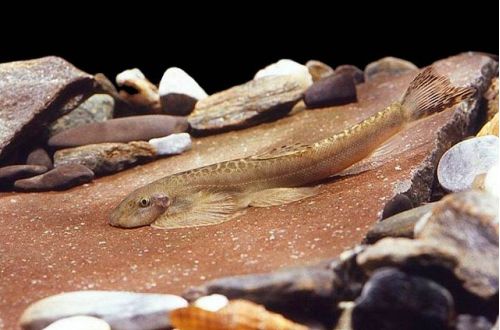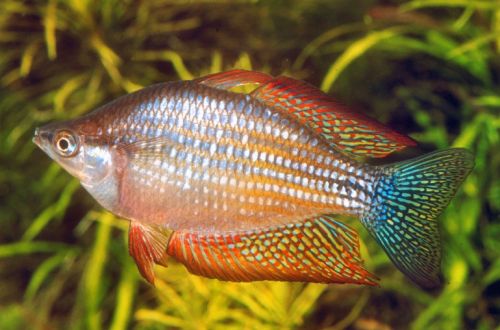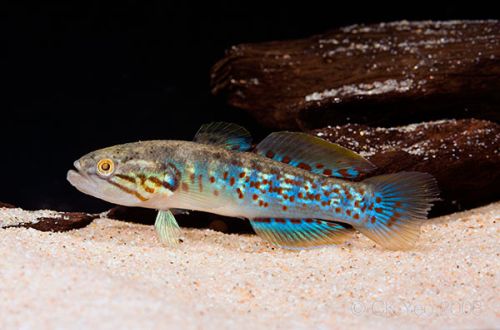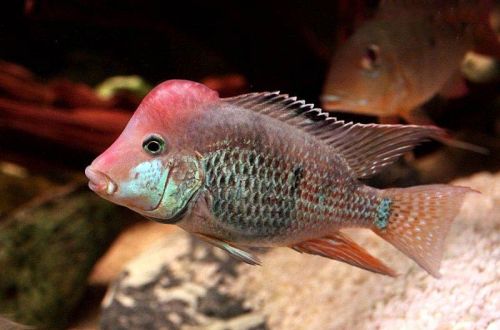
Golec Formosa
Formosan char, scientific name Hemimyzon formosanus, belongs to the family Balitoridae (river char). Perhaps not the prettiest fish and is popular mainly with enthusiasts. Relatively easy to maintain, except for the need to provide a strong current that mimics the rapid flows of mountain rivers in their natural habitat. It is the latter that is an obstacle to the selection of compatible species.

Contents
Habitat
Comes from eastern Asia. It is endemic to the island of Taiwan, located off the coast of China. Inhabits numerous mountain streams and rivers flowing from the central mountain range of the island. A typical biotope is a shallow fast stream with numerous cascades and rapids. Substrates consist of stones, boulders, snags stuck here and there. Aquatic plants are usually not found in the middle of the channel, but grow along the banks. Streams and rivers are illuminated by the sun and a biofilm of algae and microorganisms is formed on the stones – the main source of food for these fish.
Brief information:
- The volume of the aquarium – from 100 liters.
- Temperature – 16-22°C
- Value pH — 6.5–8.0
- Water hardness – soft to medium hard (2-15 dGH)
- Substrate type — stony
- Lighting – moderate / bright
- Brackish water – no
- Water movement – moderate or strong
- The size of the fish is 9–10 cm.
- Nutrition – plant-based sinking food, algae
- Temperament – peaceful
- Content alone or in a group
Description
Adults reach a length of 9-10 cm. The fish has a strongly flattened body, large ventral and pectoral fins, resembling a fan, with which it fits snugly against the surface of large boulders. Such a structure, coupled with a special structure of the mouth, similar to a sucker, will effectively resist a strong current. The tail and dorsal fin are opposite short. The coloration is gray or brownish with a pattern of light pigmentation.
Food
In nature, algae and, to a lesser extent, small invertebrates form the basis of the diet. In a home aquarium, the diet should also consist of plant materials, live or frozen bloodworms, brine shrimp, daphnia, etc. will be a useful addition. But it is worth remembering that protein foods are served in limited quantities. A number of manufacturers produce special gel-like (paste-like) feeds in tubes. They can be a good choice given the conditions these fish need to live in – strong currents. In turbulent streams, any other food will quickly be spread throughout the aquarium.
Maintenance and care, arrangement of the aquarium
The optimal size of the aquarium for a small group of fish starts from 100 liters. When keeping Formosa Char, it is important to provide clean water rich in oxygen and create a fairly strong internal current. The above tasks can be solved by installing a productive internal filter or a system of several filters. In addition to cleaning, they will become a source of strong water flow, simulating the flow of a mountain river. It is recommended that the water circulation be 10-15 times per hour, i.e. for a volume of 100 liters, the filter capacity should start from 1000 liters / hour.
The quality of the water is also affected by the regularity of the maintenance of the aquarium, in particular: the weekly replacement of part of the water with fresh water and the timely removal of organic waste (food leftovers, excrement).
The design uses the same decorative elements that are found in nature. These are stones, boulders and snags. The surface of natural snags in bright light will become a place for the appearance of algae – an additional source of food. Live plants are not usually used, but some species that can grow on woody surfaces may be used. For example, anubias, bucephalandra, some mosses and ferns.
Behavior and Compatibility
A peaceful calm fish, it gets along well with relatives and other fish that can live in such turbulent conditions, for example, with some large zebrafish, catfish Akisis, gastromisons and other chars. True, the latter are not very friendly disposition.
Breeding / breeding
At the time of preparing the materials for this article, the authors did not find reliable information about successful cases of breeding Formosa goltsov in home amateur aquariums.
Fish diseases
Health problems arise only in case of injuries or when kept in unsuitable conditions, which depresses the immune system and, as a result, provokes the occurrence of any disease. In the event of the appearance of the first symptoms, first of all, it is necessary to check the water for the excess of certain indicators or the presence of dangerous concentrations of toxic substances (nitrites, nitrates, ammonium, etc.). If deviations are found, bring all values back to normal and only then proceed with treatment. Read more about symptoms and treatments in the Aquarium Fish Diseases section.





